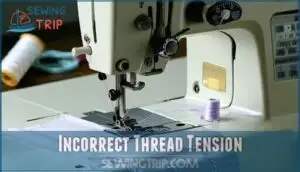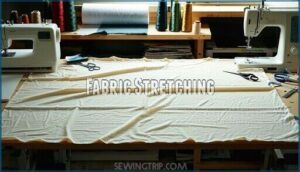This site is supported by our readers. We may earn a commission, at no cost to you, if you purchase through links.

You’ll conquer these challenges by using sharp rotary cutters, pattern weights instead of pins, walking feet for better grip, and adjusting your machine’s tension settings around 4. Pre-washing prevents surprise shrinkage, while tissue paper underneath stops fabric slippage. Light interfacing adds structure without bulk.
These targeted solutions transform your rayon projects from frustrating fights into smooth victories, and there’s more precision techniques waiting.
Table Of Contents
Key Takeaways
- You’ll conquer rayon’s slippery nature by using sharp rotary cutters, pattern weights instead of pins, and tissue paper underneath while stitching to prevent fabric sliding and distortion.
- You can eliminate stretching problems by lowering your machine’s tension settings, using a walking foot for better grip, and stay-stitching bias edges immediately after cutting.
- You’ll prevent tension issues and thread breakage by adjusting your upper thread tension to around 4, using sharp needles designed for delicate fabrics, and testing on scraps before sewing your project.
- You must pre-wash rayon before cutting to avoid surprise shrinkage, use lightweight interfacing for structure, and press with low heat using a pressing cloth to prevent shine damage.
Difficulty Cutting Rayon
Cutting rayon feels like wrestling with silk-covered ice. This slippery fabric demands respect and the right cutting tools. Start with sharp blades—dull ones create frayed nightmares. Use a rotary cutter with a fresh blade for clean cuts through this challenging material.
Rayon transforms from silk-smooth beauty into a cutting nightmare when you grab those scissors
Proper fabric preparation includes pressing gently with low heat. Place a cutting mat underneath for stability during fabric handling. The key to mastering cutting techniques with rayon lies in controlling its movement. Weights work better than pins for holding this slippery fabric in place, preventing stretching and distortion while you cut.
To achieve professional results, understanding sewing chiffon tips is essential for working with delicate fabrics.
Slippery Fabric
Rayon’s slippery surface makes it slide around like butter on a hot pan during sewing. Use pattern weights instead of pins to keep fabric stable while cutting. A walking foot grips the slippery surface better than standard presser feet.
Layer tissue paper underneath rayon when stitching—this simple sewing trick prevents fabric slippage and keeps seams aligned. Fabric stabilizers also work wonders for rayon handling. Fine needles penetrate viscose smoothly without snagging delicate fibers.
These cutting techniques and stabilization methods give you control over this challenging material. To achieve professional results, consider using rayon sewing tips to improve your skills.
Stretching Fabric
While slippery fabric challenges your cutting precision, stretching fabric tests your sewing control. You’ll master fabric distortion by reducing presser foot pressure and shortening stitch length. These stability techniques prevent unwanted stretch during seams.
Stay-stitch bias edges immediately after cutting for bias control. Use walking feet to manage grain alignment on stretchy areas. Light interfacing adds structure without bulk.
Pre-wash rayon to eliminate surprise shrinkage later. Your tension settings matter—looser tension reduces fabric pull. These stretch prevention methods transform challenging rayon into manageable material for professional results. Understanding stretch fabric basics is essential for achieving a smooth finish.
Wrinkles and Creases
Frustration builds when wrinkles and creases turn your rayon project into a rumpled mess. These delicate fibers wrinkle at the slightest provocation, but proper ironing techniques can tame them.
Start with fabric relaxation through gentle steaming methods before cutting. Use pressing tools with low heat and a pressing cloth to protect viscose from shine damage.
For wrinkle removal during sewing rayon, never drag your iron—press and lift instead. Steam lightly between seams to maintain smoothness throughout your project.
Understanding skin wrinkle effects can also help in creating realistic textile patterns.
Tension Issues
When dealing with tension issues, your sewing machine becomes the battleground between perfect stitches and fabric distortion. Thread tension problems manifest as loose stitches on top or uneven stitches underneath.
Check your tension settings first—they’re often the culprit behind thread breakage and bobbin problems. Start with upper thread tension around 4, then test-stitch on scraps. If you’re getting bird’s nests underneath, loosen the upper tension. Puckered seams? Tighten it slightly.
Remember, rayon demands gentler tension than cotton, so don’t force it. Understanding thread tension basics is essential for resolving these common issues.
Incorrect Thread Tension
Mastering thread tension prevents fabric distortion and thread breakage that plague rayon projects. Your sewing machine needs precise tension adjustment to handle this delicate material without creating loops or puckering.
- Test stitch on fabric scraps to check if threads interlock at fabric’s center
- Tighten tension (turn clockwise) if you see loops underneath the seam
- Loosen tension (turn counterclockwise) if loops appear on top surface
- Adjust bobbin tension separately for ideal stitch formation and quality
Perfect tension eliminates most sewing machine problems with rayon viscose. To achieve perfect results, understanding proper thread tensions is essential for embroidery quality.
Needle or Bobbin Not Inserted Properly
Machine malfunction often starts with needle or bobbin placement errors. When your needle isn’t seated properly in the needle bar or your bobbin sits incorrectly in its case, you’ll face thread breakage and uneven stitches immediately. Check that your needle’s flat side aligns with the machine’s requirements and your bobbin spins freely. Proper threading depends on correct insertion first.
Loose stitches signal bobbin tension problems, while thread breakage indicates needle selection issues. Take time for sewing machine calibration—it prevents these frustrating interruptions that derail your rayon projects completely. Ensuring correct thread tension settings is essential for preventing thread breakage and achieving smooth stitches.
Machine Not Threaded Correctly
Threading nightmares can turn your rayon project into a disaster zone. When your machine isn’t threaded correctly, you’ll face threading errors, bobbin issues, and incorrect tension that create sewing problems. Check your threading path carefully—even small mistakes cause major headaches.
Key threading checkpoints:
- Verify that thread follows the complete tension path through all guides and discs
- Verify needle threading direction matches your machine’s requirements
- Confirm bobbin case insertion with proper thread direction and tension
Incorrect tension from threading errors leads to thread breakage and uneven stitches. Machine calibration depends on proper threading, so double-check everything before starting your seam. Proper thread tension settings are vital to avoid common sewing issues.
Seam Puckering
When rayon seams pucker, you’re dealing with a fabric that rebels against standard sewing techniques. Seam puckering happens when thread tension pulls the delicate viscose fibers too tight, creating fabric distortion and unsightly wrinkles.
Here’s your solution:
- Lower your upper thread tension to reduce stress on rayon’s fragile structure while maintaining stitch integrity.
Use a sharp needle to prevent thread breakage and employ gentle sewing techniques. Puckering prevention starts with understanding that rayon requires finesse—treat it like the temperamental fabric it is. When tension issues arise, remember that preventing fraying and unraveling means working with, not against, the fabric’s natural properties. To achieve smooth seams, mastering proper thread tension techniques is necessary to minimize distortion.
Fabric Stretching
Stretching fabric can turn your rayon project into a frustrating mess. This slippery fabric loves to distort along the grain line, especially when you’re bias cutting. Here’s your stretch control strategy:
| Problem | Solution | Prevention |
|---|---|---|
| Fabric Distortion | Use fabric stabilizers underneath | Handle gently, no pulling |
| Grain Line Shifts | Stay-stitch curved seams | Mark grain before cutting |
| Tension Issues | Lower machine tension | Test on scraps first |
| Bias Stretching | Apply stay tape to edges | Cut with sharp rotary cutter |
Understanding stretch fabric sewing techniques is vital to mastering rayon’s quirks. Don’t fight the fabric—work with it. You’ll master rayon’s quirks with these techniques.
Frequently Asked Questions (FAQs)
Do French seams look good on Rayon?
Like silk wrapping delicate treasures, French seams cocoon rayon’s raw edges beautifully.
You’ll love how they prevent fraying while creating professional-looking garments.
They’re perfect for rayon’s delicate nature, providing structure without bulk.
Does Rayon shrink?
Yes, rayon shrinks substantially—often up to 10% when washed. You must pre-wash your fabric before cutting to avoid surprises. Skip this step, and your finished garment won’t fit properly after its first wash.
What size rotary cutter should I use if sewing with Rayon?
For cutting rayon, you’ll want a 45mm rotary cutter. This size gives you better control than larger cutters while providing enough cutting power to slice through rayon’s slippery surface cleanly without tugging or distorting the delicate fibers.
Why is my sewing machine thread not going through the fabric?
Your needle’s probably dull or wrong for rayon’s delicate fibers. Try a fresh universal needle (size 70/10 or 80/12) and reduce thread tension slightly for smoother penetration.
Why does my sewing machine have bobbin problems?
Your machine’s bobbin problems often stem from incorrect insertion, improper winding, or lint buildup.
Check you’re using the right bobbin size, clean the shuttle race, and make certain of even winding for smooth stitching.
How to diagnose sewing machine problems?
Start by checking tension settings, thread path, and needle condition. Listen for unusual sounds while running empty cycles.
Examine stitch quality on test fabric. Test different thread weights and fabric types to isolate variables systematically.
How do I prevent my rayon fabric from fraying?
Fraying rayon is like wrestling with slippery silk ribbons! Use sharp pinking shears or apply fray check to raw edges.
Overlock seams with a serger or zigzag stitch for bulletproof protection.
What type of thread should I use when sewing rayon?
You’ll want polyester or cotton-wrapped polyester thread for rayon projects. These threads match rayon’s flexibility without adding stress to delicate fibers.
Skip cotton thread—it’s too stiff and can cause puckering or breakage when your fabric moves naturally.
How can I prevent my rayon fabric from wrinkling after sewing?
Studies show rayon wrinkles 40% more than cotton after washing.
You’ll prevent post-sewing wrinkles by using lightweight interfacing, pressing seams properly with low heat, and storing garments on padded hangers instead of folding them flat.
What is the best way to stabilize rayon fabric before sewing?
Use lightweight interfacing or stay tape on seams and bias edges to prevent stretching. Apply tissue paper underneath while stitching for extra stability.
Pre-wash your fabric first to avoid shrinkage surprises later.
Conclusion
Mastering these problems sewing rayon viscose transforms your challenging projects into professional successes. You’ve now got the essential techniques to handle this temperamental fabric—from using sharp tools and proper stabilizers to adjusting machine settings for ideal results.
Remember, rayon viscose rewards patience and preparation. Apply these solutions consistently, and you’ll discover that working with this beautiful fabric becomes second nature. Your next rayon project will showcase smooth seams and impeccable finishes.













